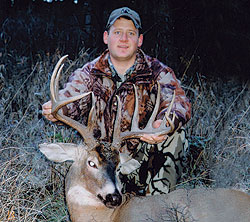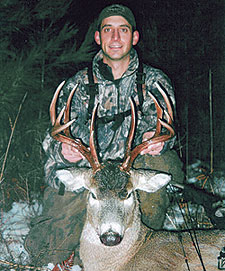November 04, 2010
By Kevin Kennedy
When an engineer plans a hunt, a solid outcome should come as no surprise.
By Kevin Kennedy

Advertisement
Brandon Enevold began drawing up plans for this buck in March, and finished his design in November. |
Advertisement
"So," I began, "how do you explain your absurd success on big whitetails? And if you were to move to a new town, could you replicate it?"
"Sure. First, what we do..." Brandon Enevold began, and for the next hour I listened and took notes. Two days later, I had a similar conversation with the other half of the "we" Brandon mentioned -- his brother Joel Enevold.
I suspect that when most hunters think of Washington, they conjure up images of tiny blacktails creeping through soggy, impossibly thick ferns and fir trees in a downpour. That picture is not entirely inaccurate, but it is incomplete. In the past 10 years, the Enevold brothers have tagged over a dozen record-book or near-book whitetail deer in Eastern Washington.
This is an impressive feat, accomplished, as you would expect, after a lifetime of effort and experience. The lifetimes involved in this case, however, are fairly short, as Brandon is just 30 and Joel only 25.
Brandon didn't start out to be a trophy hunter. He was successful with whitetails from the start, tagging a buck almost every year since his uncle got him started bowhunting at age 14. But that changed for him one December when he was in college. As always, Brandon had filled his tag with the first legal buck that came along. Then he saw a truly big buck!
Brandon and Joel have trained themselves to score bucks on the hoof quickly and accurately. Even though he wasn't as skilled then as now, Brandon is confident the nontypical that changed his world had antlers that would have measured more than 200 inches. The next year, as he passed on bucks bigger than he'd ever shot, he got skunked for the first time. His goals had forever changed, and he has never looked back.
Joel's first buck scored 1546„8 -- and he wasn't even old enough to drive to his hunting spot. Shooting a monster buck at 15 could jade a person, but Joel remains one of the most enthusiastic, focused bowhunters I've ever talked to.
Both men are electrical design engineers. The traits and skills that make them good at their jobs translate well when applied to deer hunting. Think about the old joke in which the optimist says the glass is half full, the pessimist says it's half empty, and the engineer, looking puzzled, says, "The glass is twice as big as necessary." Well, that very literal, objective-driven way of looking at the world is an important component to the Enevold way of finding big bucks.
"Engineering," Brandon explained, "teaches you to take a problem, define the desired outcome, and then break it down into its most basic elements. We treat our deer hunting exactly the same way. The objective in our case is to kill Pope & Young bucks every year."
Yeah, I thought. Mine too. Let's throw in a trophy bull elk and 100 chukars as long as we're fantasizing. But instead, I said, "Most deer hunters want a big buck every year, but usually don't even see one. What do you do differently?"
Brandon and Joel employ an aggravatingly simple, two-pronged strategy -- they hunt where big bucks live, and they hunt undisturbed deer.
Finding deer that adhere to their natural movement patterns requires some preseason legwork. It isn't easy and may result in some slammed doors as well as new friends, but it can be done. To find these hidden honey holes, Joel and Brandon smoke out small parcels of private ground. They secure permission to hunt overlooked patches of cover, some as small as five-acre home sites, as opposed to more traditional farm country. Deer in these precincts are rarely pressured during rifle season, due to the proximity of dwellings and livestock. The deer are also acclimated to people.

Joel Enevold "engineered" this Washington beauty in 2006. |
Joel and Brandon take extra care in getting to and from their stands quickly and quietly, even to the point of trimming trails to minimize brush slap. Even though they take full advantage of scent-containment clothing, they still hang their stands 25 feet high to help eliminate concerns about odor and movement.
The deer they hunt are at least as wary as any wilderness deer, and they are far more aware of people nearby. These rural and suburban bucks hear and smell people every day and aren't likely to revamp their lifestyle or leave the area because they hear a car door slam or catch a distant whiff of a human.
When the Enevold brothers are shivering in their treestands in late November, they aren't just hoping a big buck lives nearby -- they know it. They know because they hunt individual bucks. They don't always tag the buck they initially sought, but they put each stand in a specific spot because they found sign of a wall-hanger nearby. They hunt sheds in the spring as diligently as they hunt bucks in the fall. This wintertime scouting essentially allows them to do a post-mortem on the rut.
In early spring, as the snow recedes and new growth still awaits its cue, the woods are briefly November again. Like archeologists chipping away at the lava shroud covering Pompeii, Joel and Brandon get a glimpse into the past. The rubs look fresh; even scrapes are still recognizable. And at this time of year, they don't need to see deer, or even tracks. The bucks betray their presence by their sheds. A huge antler on the ground in March suggests the former owner will be nearby in the fall.
Another benefit to spring scouting is access. Most landowners are easy to talk to when you show up in March with your bundled-up six-year-old to ask if you can wander out back to look for shed antlers. After a couple of spring trips on which you show the good sense to park on hard ground and close gates, your subsequent request for hunting access will be more comfortable and more likely to result in a new hunting spot.
January 2 is the earliest Brandon and Joel have ever found a shed antler; they also have seen hard-horned bucks as late as the end of February. That reveals two important facts: 1) Bucks drop antlers over a fairly long period of time, and 2) Brandon and Joel are working on next year's bucks before many hunters have cleaned the last half of a sandwich out of last season's hunting pack.
In 2004, it was March before Brandon found the shed he was looking for. It was impressive not only for its size, but
also the seven-inch eyeguard. Brandon was on property he'd never hunted, or even scouted, but when Brandon asked permission to look for sheds in the winter, the landowner was predisposed to grant hunting permission to the responsible young fellow he'd got used to having around.
Brandon's preseason scouting gave him a good sense of natural funnels on the land, so a month before the early season, he placed his stand and waited. The early bow season runs the month of September, and Brandon hunted regularly. During that time, he had 10 bucks within range, two of them P&Y class. They were tempting, but Brandon let them walk, hoping the benefactor of the big sheds would show. He never did.
That year, the late archery season opened November 20. Joel said that every year, he hears comments about the weather. "Hunters say a storm, lack of a storm, El Niño -- something affected rut timing or intensity," he said. "It just doesn't matter. No matter what, the bucks are hot Thanksgiving week."
While the brothers normally spend a few evening hours on stand during the early season, both Brandon and Joel expect to spend most of the day in their stands during the rut. The woods are like a campus bar Thanksgiving week -- lots of attractive does roaming around, and knuckleheaded bucks being ignored by them.
Brandon had been having a great week -- he'd seen 14 bucks in four days, and soon after he climbed to his stand the morning after Thanksgiving, four spikes and an 8-point strolled by. Still, he wondered. He'd been hunting this one buck, the one that had dropped the huge antler, for eight months, and hadn't been re-warded with a quick look or even a secondhand report from anyone else. The antler said he was here, but...
Brandon heard the buck before he saw him. The raking of antlers and grunting gave him away. The buck was out of range, but even through the branches, Brandon could tell this definitely was the biggest buck he had seen all season.
When the buck quit rubbing and set off, nose to the ground, presumably tracking a hot doe, Brandon offered a low grunt. The buck glanced his way but resumed his intense tracking. The deer ignored Brandon's next grunt, increasing the distance between them -- and the hunter's anxiety.
Seeing no other option, Brandon blew his grunt call as hard as he could without sounding, as he put it, like a "scalded duck." The obnoxious grunt generated a response similar to the first; however, this time, the buck did a double-take when he noticed four does near Brandon's stand. He abandoned the track and headed straight for the cuties -- and Brandon.
The instant he swung his head, Brandon recognized the abnormally tall eyeguards and the long tines. He had looked at half of that rack almost daily since March!
When the buck stopped broadside at 25 yards to consider his next move, Bran-don put a carbon arrow through his biggest buck ever.
The deer's antlers had a gross measurement of 167 1/8 inches and a net P&Y score of 157 7/8. He was the 30th buck that had come within range of Brandon that season.
In the two seasons since, Joel and Brandon have both continued their run of whitetails that meet the standard they've set for themselves.
In the Enevold school of engineering a big buck, early scouting for sheds and secure access are the foundation. Without a target buck and a lonely place to hunt, no hunter can compensate with whitetail knowledge and shooting skill.
Most hunters would consider a year with 29 passed opportunities, a clean shot on the 30th, and a tremendous buck at the end of the trail to be the season of a lifetime. Engineers Brandon and Joel En-evold are not surprised. After all, that's the way they designed it.
Kevin Kennedy is a stockbroker and avid bowhunter from Edgewood, Washington.

